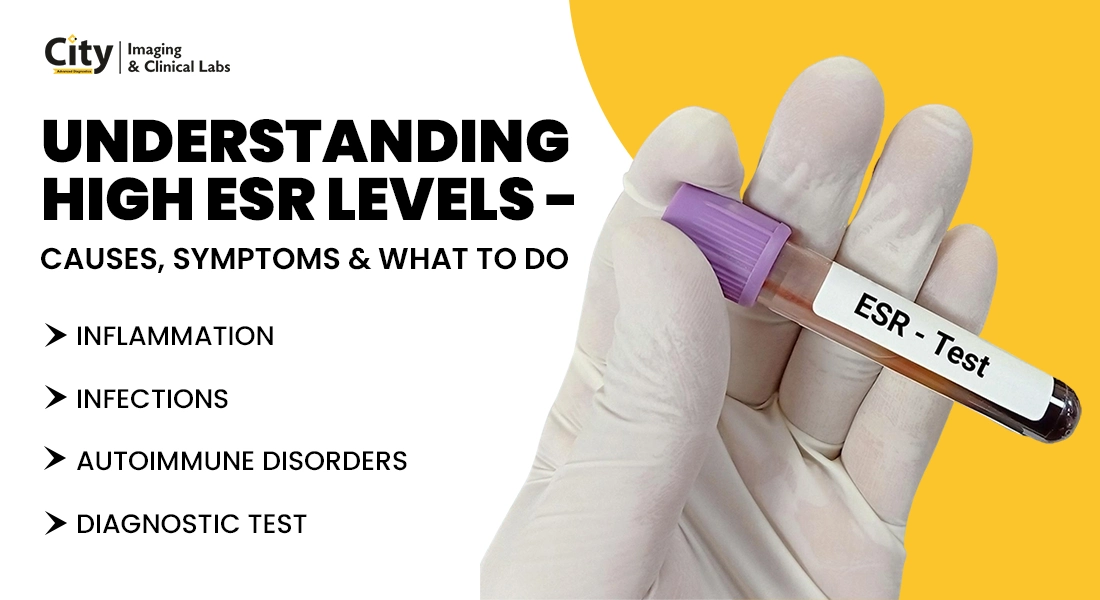High ESR Levels: Causes, Symptoms and What to Do

The erythrocyte sedimentation rate, or the ESR, is a common test that measures the rate at which red blood cells settle down. A blood sample is collected in a vial, and the rate of sedimentation is measured inside the same vial by manual or automated method. Although high ESR may not directly cause health issues but it serves as a helpful way to understand underlying inflammation or infection.
In this blog, we are going to learn about the causes of high ESR and its normal range, along with symptoms of high ESR and other valuable details.
What is an ESR Test?
The ESR test is a diagnostic step through which you can assess the timing of how fast the red blood cells separate from plasma. When inflammation occurs in your body, proteins like fibrinogen increase inside the blood. Additionally, it also causes red blood cells to clump together and sink faster.
Although this test is non-specific, however high ESR levels indicate infections, autoimmune diseases, and other chronic conditions. Therefore, it is important to have immediate medical attention in case the sedimentation rate is not normal.
What is the Normal Range of ESR?
ESR normal range in blood tests is known to vary according to age, gender, and other physiological differences. Let us have a comprehensive understanding of the ESR ranges below:
| Age (Years) | Female (mm at 1st Hr) | Male (mm at 1st Hr) |
|---|---|---|
| <50> | <12> | <10> |
| 51-60 | <19> | <12> |
| 61-70 | <20> | <14> |
| 70 | <35> | <30> |
- Menstruation and pregnancy might temporarily elevate the ESR of the blood.
- Please note that laboratories might use different ranges for ESR depending on testing methods.
What Does High ESR in Blood Test Mean?
A high ESR indicates that there might be possible inflammation in your body, but this is not definitive. Some common high ESR causes include the following:
- Infections, which might be bacterial or fungal
- Autoimmune conditions like rheumatoid arthritis, lupus (Systemic Lupus Erythematosus), and vasculitis
- Chronic conditions like kidney disease, thyroid disorders, and cancer
- Tissue injury or post-surgery trauma
However, if the ESR is consistently high, further tests are warranted to identify the disease.
What are the Symptoms of High ESR Levels?
Some of the common symptoms of high ESR are as follows:
- Fatigue, fever, or, in some cases, unexpected weight loss
- Joint pain or stiffness, which is often common in autoimmune conditions
- Persistent headaches indicating temporal arteritis
- Anaemia-related symptoms like paleness and shortness of breath
Please note that these are non-specific symptoms of high ESR, and further tests must be performed to create a proper disease profiling.
What to do When ESR Increases?
If you find that your ESR is unexpectedly high, there is no reason to worry; you must visit your nearest practician. Additionally, note the following steps:
-
Identify the cause of the disease
Most of the time, the doctors might advise you to opt for CBC with ESR test combined. This helps to understand if you have anaemia or infections.
Please note that CBC with ESR might also be paired with:
- C-Reactive Protein to directly measure the levels of inflammation
- Ferritin and iron studies are also conducted to rule out the possibility of anaemia
- Autoantibody tests are also used to diagnose autoimmune issues, like the ANA test for lupus
-
Address the Underlying Conditions
If you already have some diseases, then the doctors might advise you for antibiotic treatments, immunosuppressants (for autoimmune conditions), and pain relievers to manage inflammation.
-
Lifestyle Adjustments
- Follow an anti-inflammatory diet rich in omega-3 fatty acids and leafy green vegetables.
- Practice regular stress reduction techniques like meditation or yoga to support overall health.
- Quit smoking, as it significantly impacts your ESR levels.
Additionally, you must note that the treatment of high ESR is mostly focused on resolving the root cause rather than lowering the ESR itself. Just like fever, high ESR is not a disease, but it suggests an underlying condition in the human body.
Conclusion
The ESR test is a valuable tool for detecting inflammation, but it’s not diagnostic on its own. Understanding the normal range of ESR in blood tests and recognising raised ESR symptoms help guide timely medical evaluation.
Always pair ESR results with clinical symptoms and additional tests like CBC for a comprehensive health assessment.
DISCLAIMER: THIS WEBSITE DOES NOT PROVIDE MEDICAL ADVICE. The information including text, graphics, images, and other material contained on this website is for informational purposes only. No material on this site is intended to be a substitute for professional medical advice, diagnosis, or treatment. Contact a health expert if you have questions about your health.




_Test_1100x600.webp)




Comments List